An Easter weekend on lockdown presents as good a time as ever to evaluate your wine collection. While it can be tricky to keep track of what you’ve got and when you should drink it, Wine Lister’s various online tools allow detailed analysis of your collection and can guide future purchases, whether for drinking or investment.
This week’s blog post examines two of the most popular Wine Lister website features amongst collectors, starting with the MUST BUY recommendation tool.
Wine Lister’s proprietary recommendation algorithm produces a dynamic list of wines with high quality that show value within their respective vintages and appellations, helping wine lovers buying at almost every level to make the best choices for their desired region, style, or vintage.
There are currently 1,665 MUST BUYs out of the 30,000+ labels on Wine Lister. See the chart below for a breakdown of MUST BUYs by region – an indication of what a diverse portfolio could look like for the modern collector.
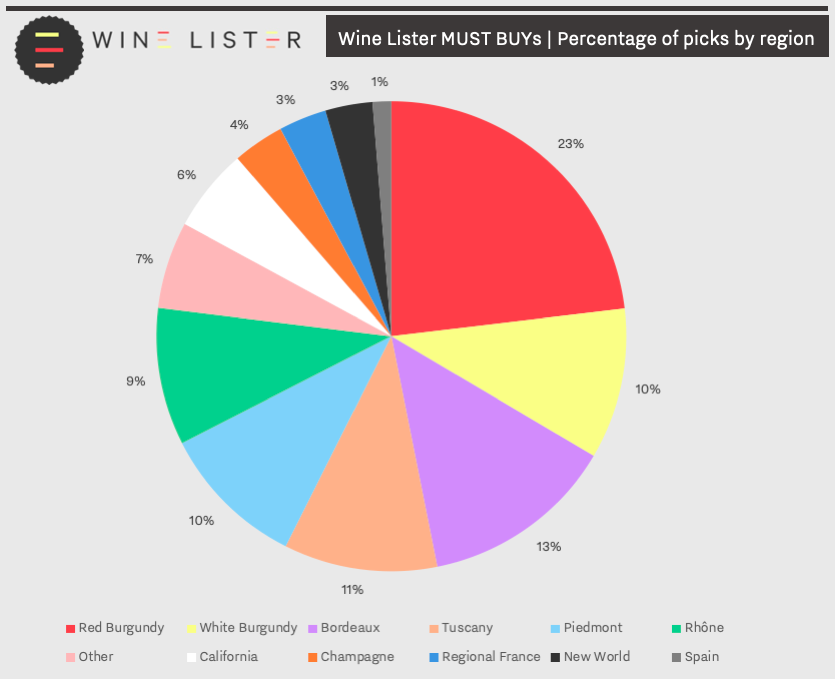
While the same chart from a decade ago may have been dominated by Bordeaux, the global demand and secondary market values for Burgundy’s top wines have continued to spiral upwards. Burgundy represents the greatest percentage of MUST BUY wines, with red and white recommendations accounting for 33% of all MUST BUYs collectively. The red Burgundian MUST BUYs feature a range of prices starting from the most expensive, DRC’s Romanée-Conti 2015 (available at £14,500 per bottle in-bond), down to 64 wines priced at £100 or under, including Stéphane Magnien’s Clos Saint-Denis 2010 (available at £76 per bottle).
Bordeaux represents 13% of MUST BUYS, and also encompasses a wide range of prices, from six vintages of Petrus (with an average price of £1,990 per bottle) down to two vintages of Marsau (priced at £12 and £13 respectively). Tuscany, Piedmont, and the Rhône follow closely behind, while California makes up the largest proportion of New world MUST BUYs.
With so much MUST BUY choice available, you may wish to filter these by top regions, and then further by Wine Lister Indicator. For example, filter results by ‘Investment staples’ to see wines that are long-lived (but not too old), and have proven wine price performance, while staying relatively stable and liquid.
Wine Lister’s Compare tool can then further refine your investigation, by displaying your selected MUST BUYs side by side. This is illustrated below using three 2016 Saint-Estèphe MUST BUYs – Cos d’Estournel, Calon Ségur, and Montrose. While Calon Ségur appears to be the best value, Montrose has the highest scores from Wine Lister’s partner critics, and therefore the better WL score overall.
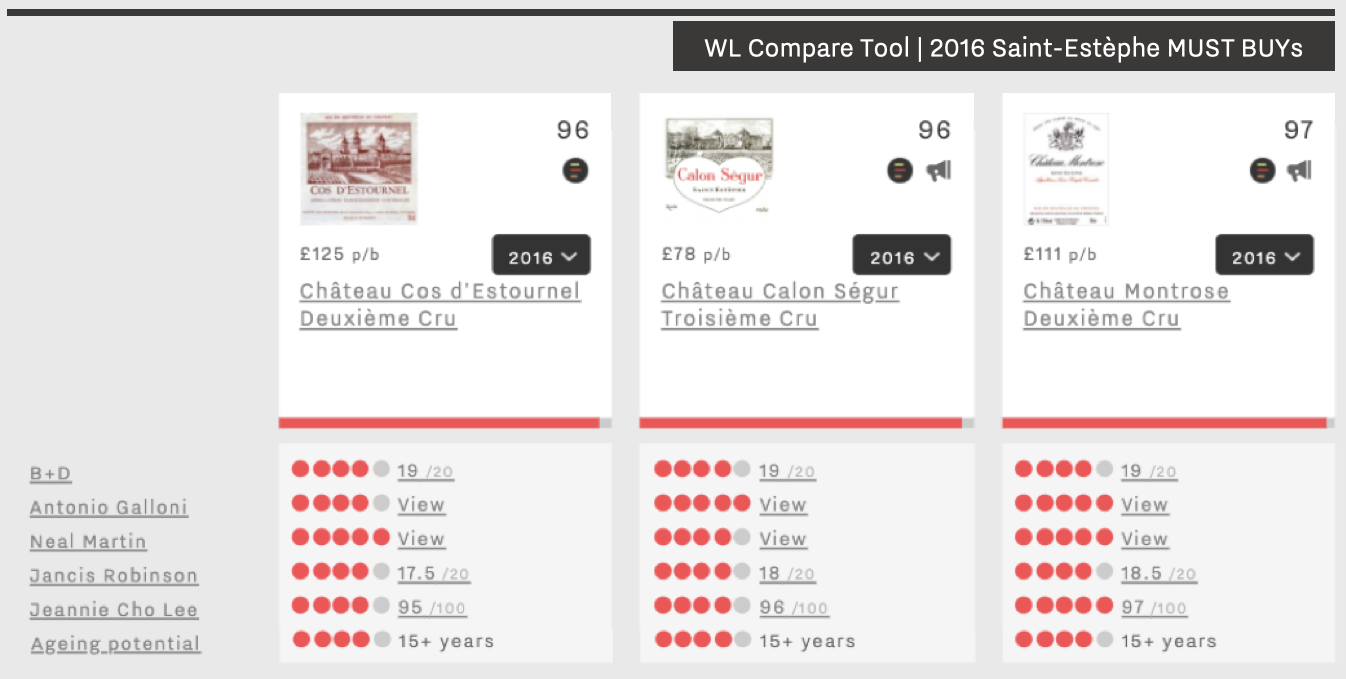
See the above comparison for yourself, or start your own wine comparison here.
Wine Lister is currently offering a range of portfolio analysis services to private clients, from detailed geographical split and further purchase advice, to investment forecasting and a fully-fledged “drink vs. sell” plan. If you are interested in having your wine collection analysed by our team of fine wine data experts, please don’t hesitate to contact us.
As we spare a thought for Bordeaux during what would have been the 2019 en primeur tasting week, we continue to encourage our readers to investigate the abundance of physical vintages available from this noble region. This week we examine the top Bordeaux MUST BUYs in four of the five left bank classified growth groups.
Though the tasting and sale of 2019 may be postponed, 17 reds from last year’s en primeur campaign (2018) still appear in our top MUST BUYs selection, and are worth snapping up for future drinking. The impressive quality of recent physical vintages in Bordeaux, namely 2016 and 2015, is clear to see – each vintage earns 10 and nine MUST BUY places respectively in the Wine Leagues below.
Of the 222 Bordeaux wines that are currently identified as MUST BUYs, 97 are Médoc classified growths. Looking at the top 10 wines for ‘Cru Classé’ levels (second to fifth), WL scores indicate that the quality structure intended in the 1855 classification is perhaps not so rigid, now that modern winemaking techniques have more of an influence. For example, five wines in both the third and fourth growth groups earn 94 WL, and six wines among top fifth growths earn the same score.
These rankings are formulated by Wine Lister’s new interactive tool – Wine Leagues – which can be accessed here.
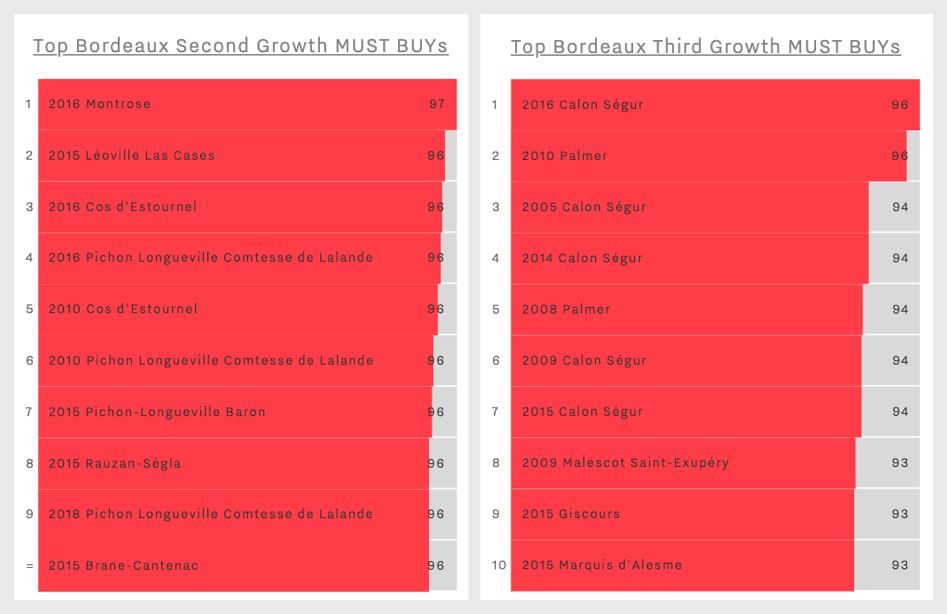
With a WL Score of 97, Montrose’s 2016 release takes the lead spot in the list of top Bordeaux second growth MUST BUYs. Awarded 98 points by Wine Lister partner critic, Antonio Galloni, and described as ‘a wine of pedigree, depth and character’, this wine comes at price of £111 (per bottle, in-bond, when buying by the case). Super-second Pichon Comtesse features three times – with 2016, 2010 and 2018 vintages present. The latter two vintages are available in-bond at Goedhuis & Co – the 2010 would make for a great lockdown indulgence, whilst the 2018 is an investment for future drinking.
Calon Ségur dominates the Bordeaux third growth wine league, occupying half of the top 10 spots with vintages 2005, 2009, 2014, 2015 and 2016. The average cost of these vintages is £71 (per bottle, in-bond). Palmer features twice, though at a higher price – its two listed vintages (2008 and 2010) are available at £204 and £155 respectively from BI Fine Wine & Spirits.
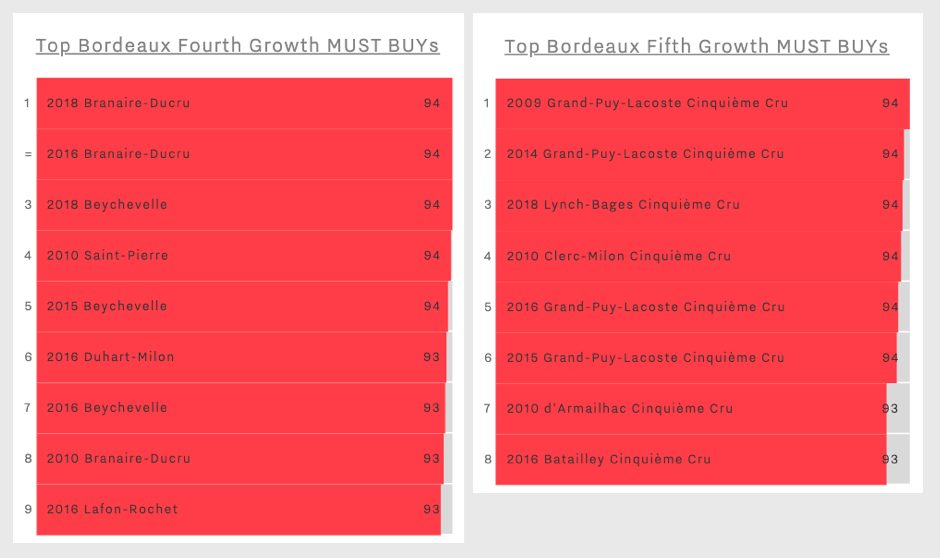
The top Bordeaux fourth growth MUST BUY list is dominated by more recent vintages (2015-2018). Occupying the top two positions with its 2018 and 2016 releases, Branaire-Ducru has a notably good quality-to-price ratio. Both vintages achieve a WL Score of 94 at the cost of £38 per bottle (in-bond). The 2018 Branaire-Ducru achieved special mention in last year’s examination of WL MUST BUYs from Bordeaux en primeur 2018, as did Beychevelle. Both wines are available to purchase by the case (in-bond) at Albany Vintners.
Of the 18 Bordeaux fifth growths, eight achieve MUST BUY status. Grand-Puy-Lacoste achieves multiple entries on the League, with 2009, 2014, 2015 and 2016 all receiving a WL Score of 94. These four deliverable vintages are available from several UK merchants including Berry Bros & Rudd, where prices start from £245 for the 2014 vintage (per case of six in-bond). Described by Neal Martin as ‘one of the great vintages from this estate in the modern era’ the cost of the 2009 supersedes its descendants – a case of six bottles starts at £450 (in bond).
All users can see the standard Wine League page here. Pro users have access to a more extensive set of Leagues, and can log in to access here.
While we would normally be packing our bags in preparation for one of Wine Lister’s favourite weeks of the year, the postponement of this year’s Bordeaux en primeur tasting week comes as a blow for all. Until we can sample the eagerly-awaited 2019 vintage, we can comfort ourselves in self-isolation with the abundance of physical Bordeaux vintages still available for delivery.
In celebration of the brilliant wines that are helping keep Wine Lister’s glasses half-full during the pandemic, this week we focus on some of the best red Bordeaux Value Picks, so that you too can avoid compromising on your quarantine drinking preferences without breaking the bank.
Wine Lister’s Value Pick score is calculated based on the quality-to-price ratio of a wine and vintage, as informed by price data and reviews from our partner critics. See the image below for five of our top Bordeaux Value Picks over the past four vintages.
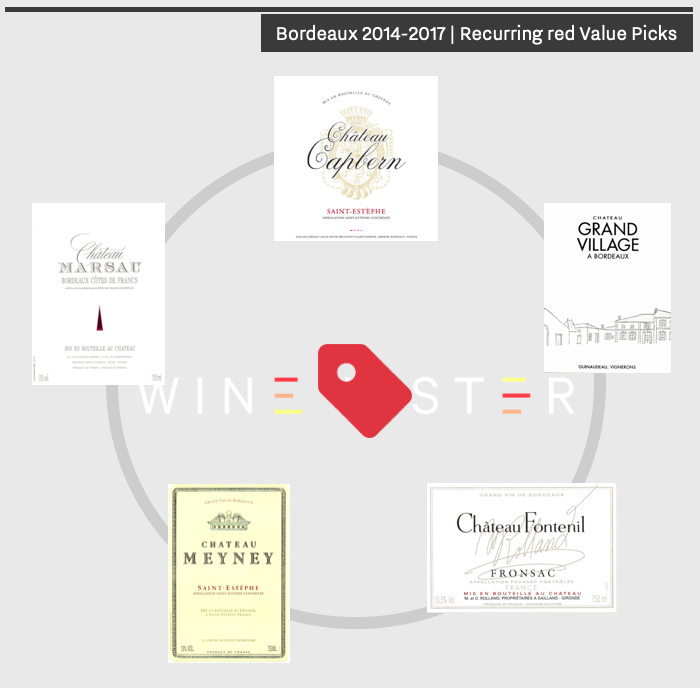
- Château Capbern
Capbern obtains an average Value Pick score of 35 across the last four deliverable Bordeaux vintages, and offers excellent value for money. This Saint-Estèphe château is the sister property of Calon-Ségur. Described by one of our partner critics, Jancis Robinson, as a ‘veritable steal’, the 2014 vintage ‘continues to look exceptionally good and still fully deserving of its score of 17 en primeur’. The 2016 vintage achieves Capbern’s highest WL Value Pick score (36.2) of the four vintages, and we highly recommend getting your hands on some, available by the dozen in-bond starting from £200, from UK merchants including Farr Vintners and FINE+RARE. Millésima USA and Millésima HK also deliver this brilliant wine.
- Château Grand Village
Achieving Value Pick status for three of the four vintages examined (2017, 2016, 2015), Grand Village exhibits a dependably high quality-to-price ratio. As the original Bordeaux home of the Guinaudeau family – the producers of Lafleur – Grand Village is the accessible answer to the same exceptionally high winemaking standards applied to its parent wine. Its classification as a Bordeaux Supérieur plays a part in its inherently reasonable price (c.£13 per bottle in-bond, when buying by the case). Grand Village’s 2017 vintage achieves the highest Value Pick score (38) of all five wines and four vintages here mentioned, and is available for delivery from the Guinaudeau family wines’ UK agent, Justerini & Brooks.
- Château Fontenil
A second Value Pick from an ‘outlying’ Bordeaux appellation, Fontenil’s 8.5-ha vineyard is located at the highest elevation on the plateau of Fronsac. As renowned flying winemaker, Michel Rolland’s ‘passion project’, he purchased the site with his wife, Dany, in 1986 with the intention of inhabiting the house that was situated on its land. Taking on the responsibility of attending to the vines that came with it, and creating an entirely new estate, Fontenil is now a boutique wine of excellent quality at an average cost of c.£20 per bottle in-bond. Given its small production volume, Fontenil is not as easy to find as our other four Value Picks, however, in the UK, Laithwaites is the place to buy (as soon as they reopen their website for orders – they are currently experiencing an overload of demand due to lockdown buying).
- Château Meyney
Located in the east of Saint-Estèphe, the plots of this Cru Bourgeois are situated next to Montrose. Long considered a wine trade darling for its impressive value, Meyney continues to achieve high WL scores. Its 2015 vintage received particular praise from our partner critics, with Neal Martin describing it as ‘blowing everyone’s expectations, including his own‘. With prices starting at £25 per bottle in-bond, you can order this wine through Goedhuis in the UK, where a case of 6 bottles stands at £200, including VAT. If you are in the USA, you can place your order with Millésima.
- Château Marsau
Like Meyney, Marsau’s 2014 and 2015 vintages are Wine Lister Value Picks. The 2016 is too, and though the wine seems to get better every year, the latter may need a touch more time in bottle before drinking. Marsau is run by Anne-Laurence and Mathieu Chadronnier (Managing Director of the Bordeaux négociant, CVBG). The Marsau vineyards feature 85% Merlot planted on predominantly clay soils, resulting in a classically right-bank wine with soft, round fruit and great balance. The 2014 vintage represents particularly good value – priced at £20 for the bottle in-bond, with a high Value Pick score of 35. The UK-based merchant BI Wines is delivering this vintage, whilst those on the other side of the pond can place their order with JJ Buckley Fine Wines.
You can identify good value in further back vintages of any of the above-mentioned wines by using the Vintage Value Identifier on each wine page. See the example for Meyney below or by clicking through to its wine page here.
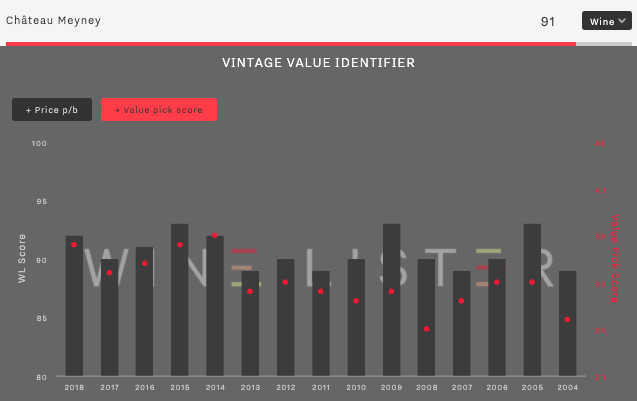
While the world continues to tackle the outbreak of Covid-19, we at Wine Lister are trying to continue with “business as usual” – at least as far as is possible, while also thinking of all our friends in wine regions and markets that are struggling in this uniquely difficult time. This of course includes California – that idyll for sunshine and free love as featured in many a hit song and many a hit wine list.
Of all fine wines from the New World, offerings from California have succeeded in grabbing the attention of fine wine collectors, with some even reaching “cult” status. With this in mind, we are California dreaming this week, and examine below the wines from California’s foremost regions – Napa and Sonoma Counties.
Both production areas offer an abundance of top-quality wines, though at a price. The high prices of several Napa County AVAs, including Oakville and the Napa Valley, mean that its wines can appear expensive when compared to its sibling, Sonoma County.
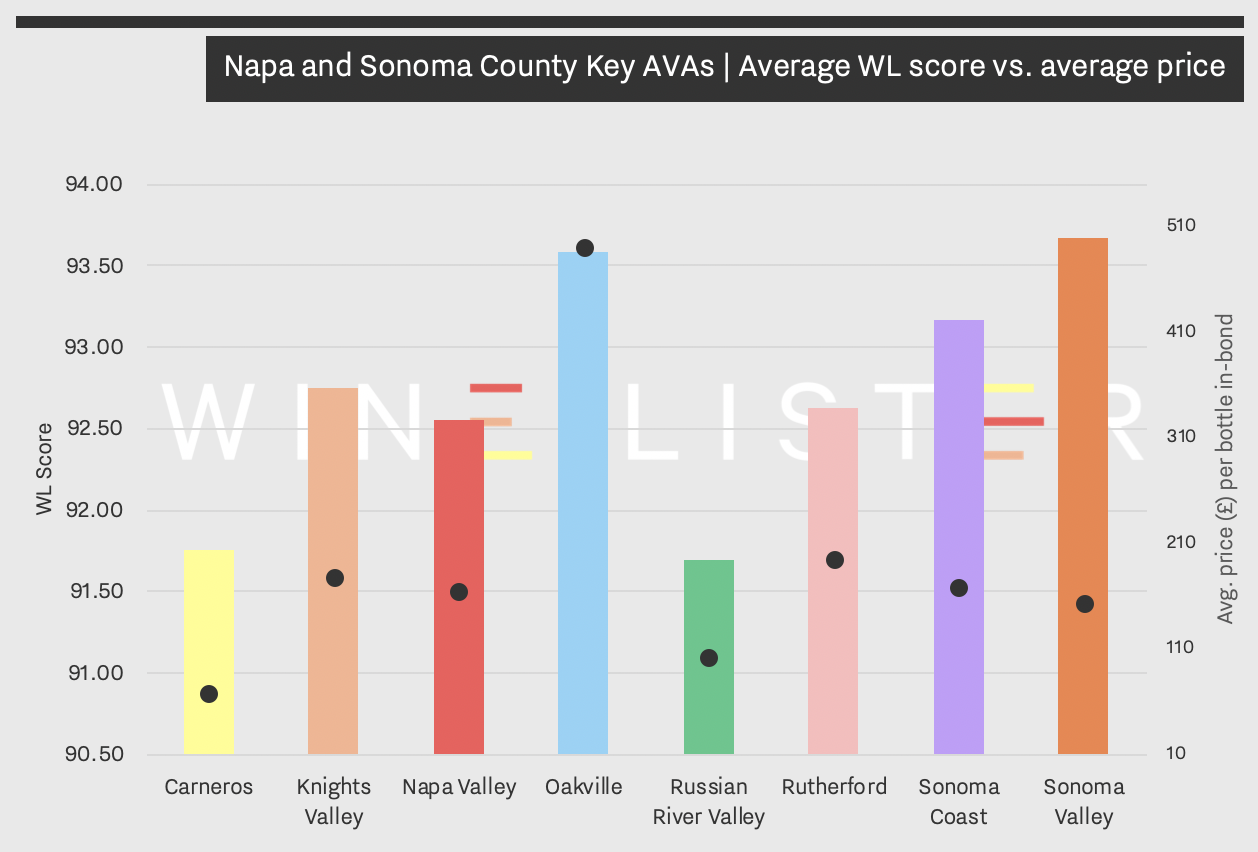
The chart above shows the average WL Score and price (£) per bottle in-bond (when buying by the case) of the top eight AVAs in Napa and Sonoma Counties.
Two AVAs consisting only of white wines stand in stark contrast. Carneros is represented by four Chardonnays – Kistler Vineyards’ Hudson Vineyard, Ramey Wine Cellars’ Hudson Vineyard, Shafer Vineyards’ Red Shoulder Ranch, and Cakebread’s Chardonnay Reserve, earning an average WL score of 91.8. Accompanying its relatively low WL score is the second-lowest average price of all AVAs – c.£67 per bottle in-bond. This remains excellent value in the wider fine wine context, given that Chardonnay with similar scores from Burgundy can fetch up to c.£1,000 (for example, Coche-Dury’s Meursault Les Caillerets).
At the other end of the quality scale is Sonoma Valley AVA, represented by three Chardonnays from Kistler Vineyards. Its average WL score of 93.7 is the highest amongst its Californian peers. Considered a cult Californian winemaker, the Kistler Winery emulates the Burgundian “terroiriste” approach, committing wholeheartedly to wines that best reflect each individual plot.
The Napa County groups command a higher price tag on average than their Sonoma counterparts. Oakville’s selection of predominantly red wines holds the second-highest WL score, however its average price is over double that of the second most expensive region – Rutherford. This is explained by the presence of Screaming Eagle Cabernet Sauvignon, which, at an average price of £2,863 per bottle, drives the region’s quality-to-price ratio down. The mailing list model of Jean Philips’ low-production Napa Valley winery has amassed an incredible cult following of fine wine buyers, who seemingly seek access to the wine at any cost.
While Sonoma County may appear to offer the better value (with red wines such as Kenwood Vineyards Artist Series Cabernet Sauvignon, or Hirsch Vineyards Block 8 Estate Pinot Noir, to add examples to Kistler’s whites), Wine Lister’s top 10 Californian MUST BUYs are all from Napa County.
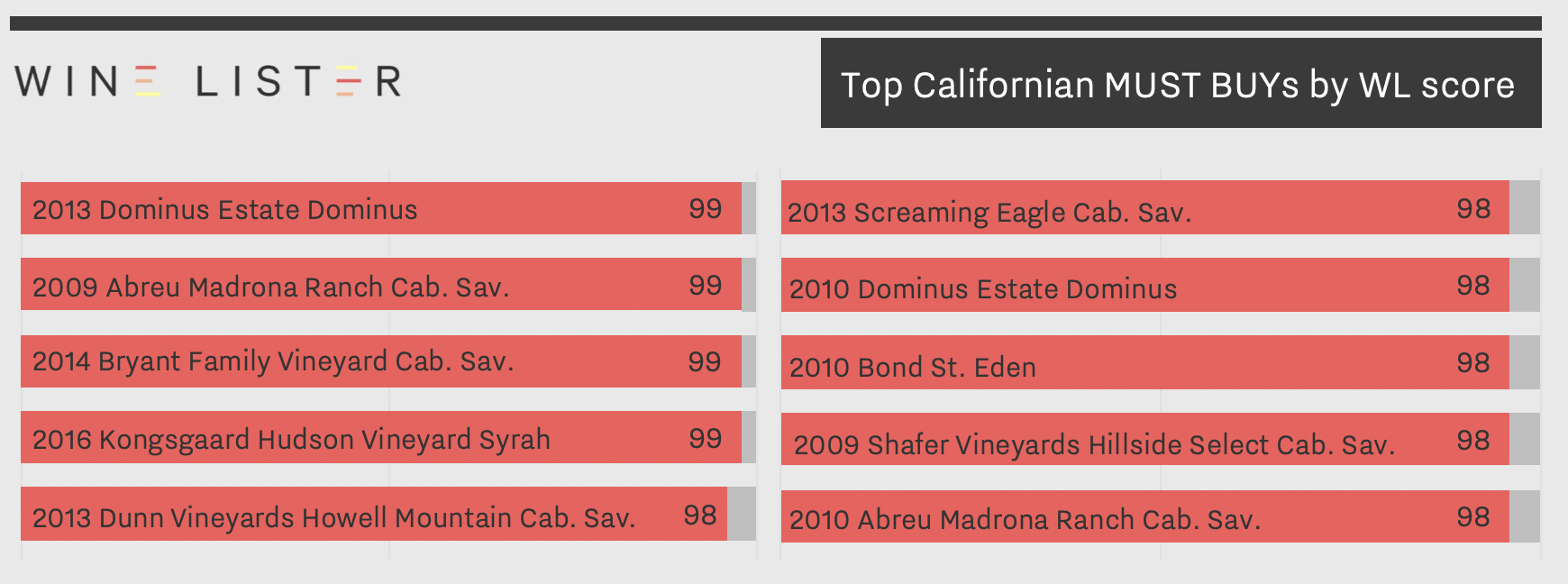
Of these, all are produced in the Napa Valley AVA except Screaming Eagle’s 2013 Cabernet Sauvignon. Dominus Estate achieves two mentions, with vintages 2013 and 2010 both featured. Perhaps unsurprisingly for the New World king of Cabernet Sauvignon, the top 10 Californian MUST BUYs includes just one alternative grape variety – Kongsgaard’s 2016 Hudson Vineyard Syrah.
Explore all 94 Californian MUST BUYs here.
While the outbreak of Coronavirus continues to threaten the global stock market and international commerce, it is understandable that the fine wine trade and collectors alike are feeling the pressure, not to mention wine producers – especially in hard-hit Italy. The cancellation and/or postponement of wine fairs across the globe may hinder new releases from catching their usual momentum, but those with significant back stocks of older vintages may have a way to navigate today’s choppy seas.
Wine Lister has been working on a new tool to complement WL MUST BUYs, and while now may not be the perfect time for such a release, we launch it in the hope of providing inspiration for the sale and purchase of wines that could be hiding In Stock, and in a continued effort to support producers and the wine trade during difficult times.
The new tool, Wine Leagues, provides hit lists of the very best wines to source for a given set of criteria, be it appellation, price, or WL score. We hope the top 10s on this new page will speak to all fine wine lovers, be it for “unicorn” wines, or just ultra-high quality wines that any collector should consider for their collection.
The current set of Leagues examines Italy, with the first list focusing on its top Value Picks. The top 10 Italian Value Picks hail from a handful of key producers – Fontodi, Isole e Olena, and San Giusto a Rentennano feature multiple times.
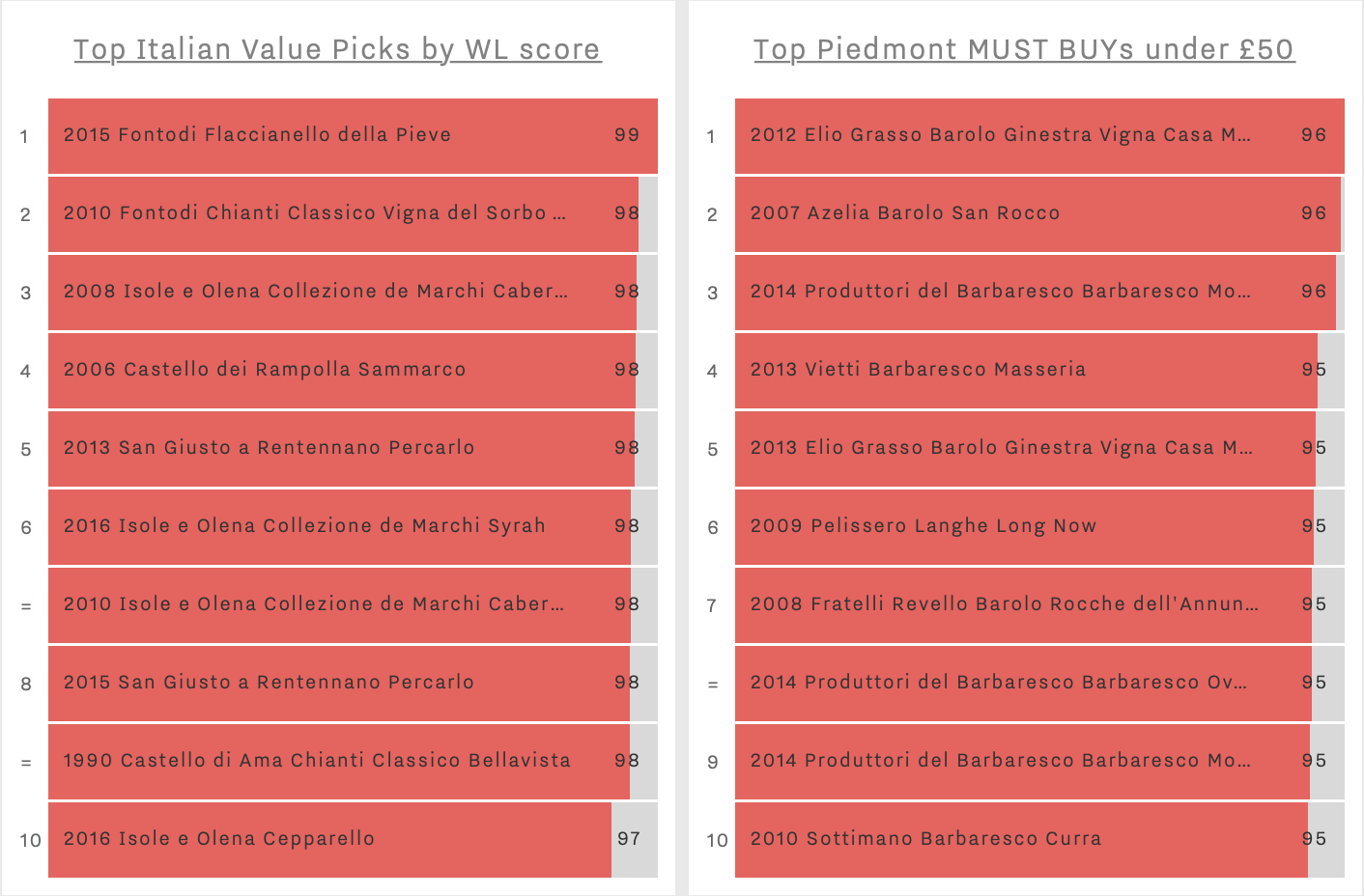
Barbaresco recommendations take the majority of top spots in Piedmont’s MUST BUYs under £50 (per bottle, in-bond when purchased by the case). Barolos from Elio Grasso, Azelia, and Fratelli Revello also make the cut, alongside Langhe offerings from Vajra and Pelissero.
Moving into France, we examine Hidden Gems from the Rhône, and Value Picks from Bordeaux. Tardieu-Laurent features three times in the Rhône Hidden Gems’ top 10 by WL score, for an Hermitage Blanc, a Gigondas, and a Cornas. Three Côte Rôties make it into the top 10, from producers du Monteillet, Pierre Gaillard, and Patrick and Christophe Bonnefond.
Top Bordeaux Value Picks render a number of deliverable vintages going back as far as 1995, as well as two wines from the latest en primeur release – Barde-Haut and Latour-Martillac 2018s. Super-second growth Pichon Comtesse’s second wine also features. The 2016 Réserve de la Comtesse was recently highlighted in a focus on Bordeaux MUST BUYs.
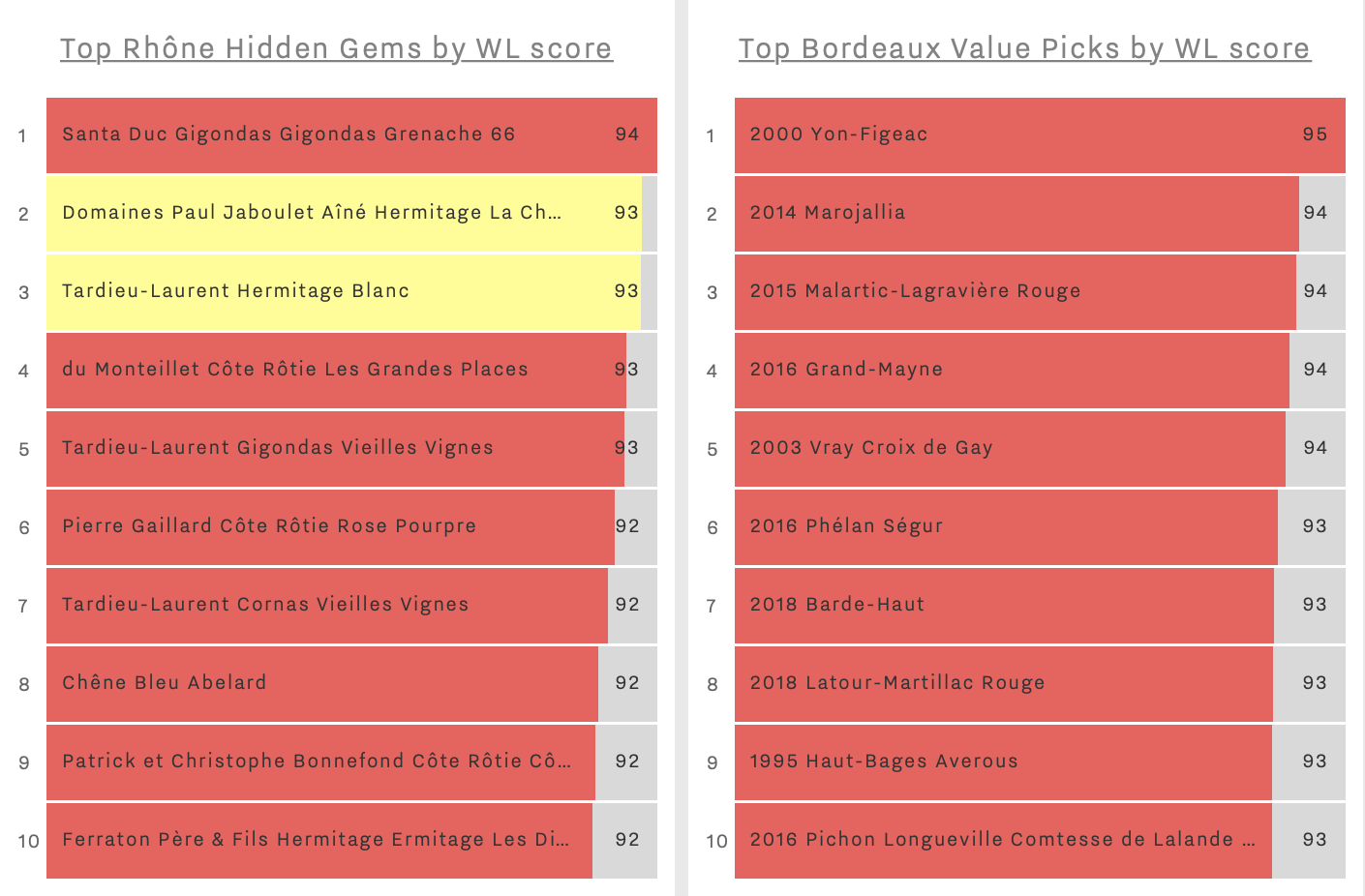
All users can see the standard Wine League page here. Pro users have access to a more extensive set of Leagues, and can log in to access here.
Faced with a new generation of fine wine buyers seeking more of the “weird and wonderful”, let alone recent economic obstacles – Coronavirus keeping drinkers off the streets, US tariffs on European wines – Bordeaux can struggle to find space to thrive.
Bordeaux’s traditional image compared to more fashionable regions such as Burgundy, Piedmont, or Champagne means its prices are lagging behind. The silver lining is that Bordeaux appears excellent value for the high quality available in comparison.
Wine Lister’s dynamic buy recommendation tool currently identifies 219 Bordeaux wines as MUST BUYs – just 19 fewer than the original MUST BUY list from September 2019.
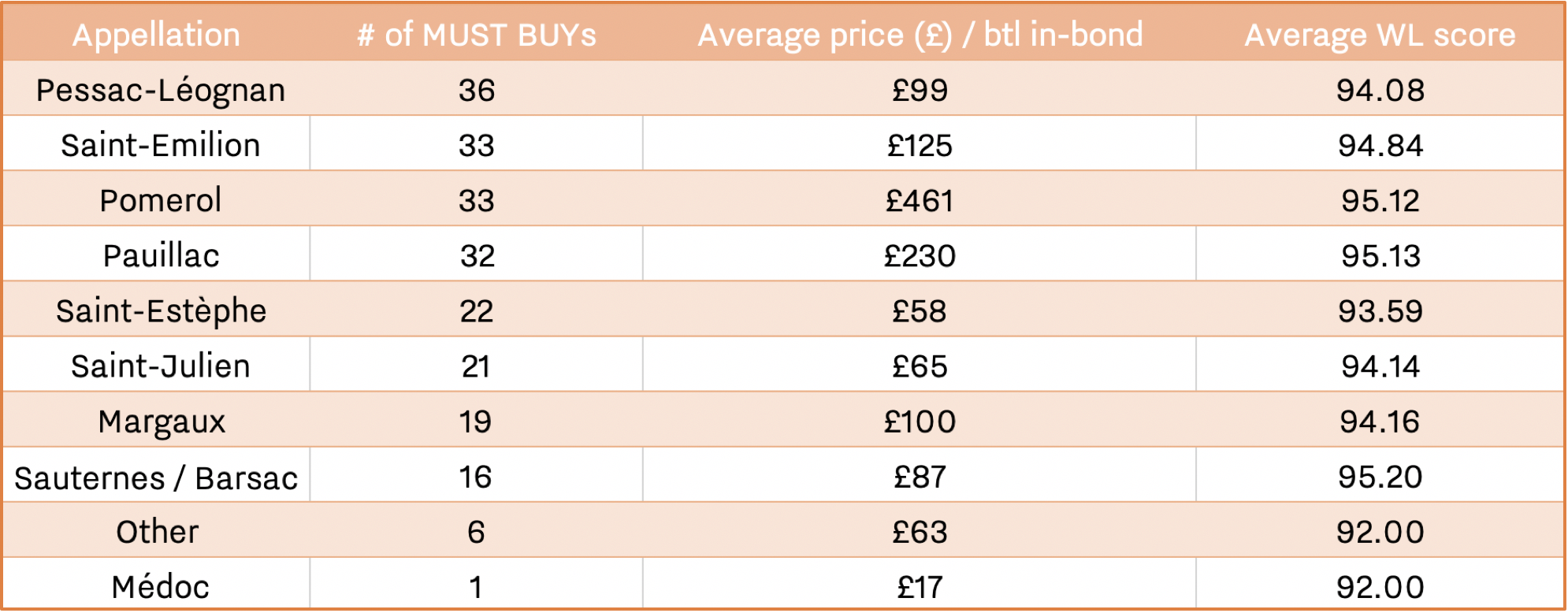
The above table shows each Bordeaux appellation by number of MUST BUYs, as well as average price and WL score of each MUST BUY appellation group. Marking the delayed opportunity presented by slow price evolution post-en primeur, 2016 is the most-featured vintage, achieving 40 entries out of the 219 Bordeaux MUST BUYs (or 18%).
Leading MUST BUY appellation Pessac-Léognan is made up of 28 reds and eight dry whites. Producer Domaine de Chevalier features particularly heavily, earning MUST BUY status for 1981, 2009, 2014, 2015, and 2018 for its red wine, and 2004, 2009, 2010, and 2013 for white. Its second red wine, L’Esprit de Chevalier, appears for the 2016 vintage.
Smith Haut Lafitte and La Mission Haut-Brion share the remaining white places between them, while Haut-Bailly, Haut-Brion, Latour-Martillac, and Malartic-Lagravière achieve multiple entries for reds only. Price-rising superstar Les Carmes Haut Brion features for just one vintage – the 2017.
Right bank appellations Saint-Emilion and Pomerol share second place, with 33 MUST BUYs each. They both earn slightly better average WL scores than Pessac-Léognan, but at prices 26% and 366% higher respectively on average than Pessac counterparts.
The large price difference is hardly surprising in Pomerol, given that its MUST BUY hoard includes five vintages of Petrus, and one of Le Pin. Without these, the average price of Pomerol MUST BUYs is £171, and there are still options at the more affordable end (such as 2016 Vray Croix de Gay).
Powerhouse Pauillac comes next, and includes 14 first growth entries. Mouton takes the lion’s share of these, featuring seven vintages from 1996-2018. Latour earns five places (including one much older vintage – 1964), and Lafite two. Pichon Comtesse also features heavily, earning five MUST BUYs for its grand vin, and one for the Réserve de la Comtesse.
In terms of pure value for money, the one MUST BUY from the Médoc appellation – Potensac 2018 – wins out, followed more generally by Saint-Estèphe’s 22 MUST BUY entries. Perhaps unsurprisingly, its crowned king is Calon Ségur, earning MUST BUY status for five vintages – 2005, 2009, 2014, 2015, and 2016.
Explore all 219 Bordeaux MUST BUYs here.
This week Wine Lister published its first in-depth study of 2020, focusing on the leading wines and producers of Piedmont.
The key takeaways from the report prove Piedmont to be somewhat of an enigmatic region, earning high praise from critics, and experiencing strong long- and short- term price performance, while still lagging behind in terms of consumer popularity.
While this is perhaps a consequence of Nebbiolo’s relative obscurity when compared with international grape varieties, Piedmont’s unique position – a veritable treasure trove of gems to uncover – presents a real opportunity both for vinous discovery and future value.
Wine Lister Pro members can read the full Piedmont report here. All free users can purchase the report for £200 from Wine Lister’s Analysis page.
Below we examine the top Barolos and Barbarescos by WL score.
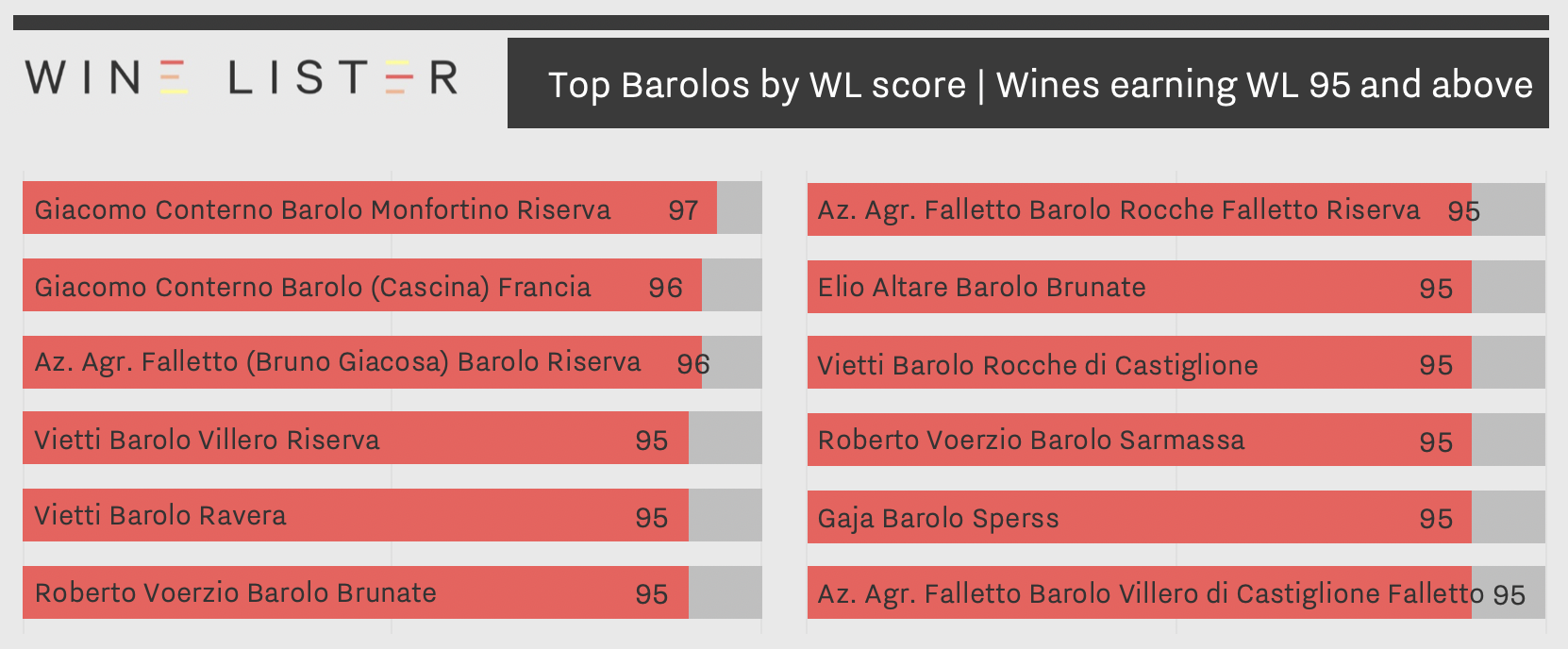
Giacomo Conterno takes both first and second places in the ranking of Barolos by WL score. The icon wine, Barolo Monfortino Riserva is the only Piedmont wine to earn a WL score of 97, while the Barolo Francia shares its score of 96 with the Barolo Riserva from the legendary Bruno Giacosa’s négociant outfit, Azienda Agricola Falletto, as well as the two highest-scoring Barbarescos (see below).
While earning joint-second place for the straight Barolo Riserva, Falletto also features for two site-specific bottlings, the Barolo Rocche Falletto Riserva and Barolo Villero di Castiglione Falleto, making the renowned house the joint-most prolific producer in the top Barolo rankings shown. It shares this position with Vietti, which earns WL 95 for its Villero Riserva, Ravera, and Rocche di Castiglione Barolos.
Elio Altare’s Barolo Brunate is the most reasonably priced of these top 12 Barolos, with an average price of £112 per bottle in-bond (when purchased by the case). Both of Roberto Voerzio’s highest-scoring wines, the Sarmassa and Brunate, follow with average prices of £152 and £165 respectively.

Eight Barbarescos achieve a WL score of 95 or above. The appearance of multiple wines per producer is accentuated here, with Roagna and Gaja earning three places apiece, followed by two Barbarescos from Falletto (totalling seven wines in Falletto’s hoard of WL scores of 95 and above).
Both sets of rankings provide useful leads in terms of producers to look out for, particularly heading into further releases of Barolo’s latest vintage, 2016, in the spring. For more specific recommendations of further Piedmontese wines and back vintages, see the region’s full list of MUST BUYs, and / or Piedmont’s Hidden Gems.
With Burgundy en primeur coming to a close – and such a good array of 2018s to choose from at that – fine wine collectors might feel inclined to tighten their purse strings over the coming months (perhaps until the next big campaign to come – Bordeaux 2019 en primeur). For those unable to resist the temptation of continuing to grow their wine collection, the Rhône is a perfect resting place for high-quality drinking wines.
This week we focus on a subset of Rhône MUST BUYs – those under £100 per bottle in-bond (when bought by the case), with WL scores above 95, of which there are 36.
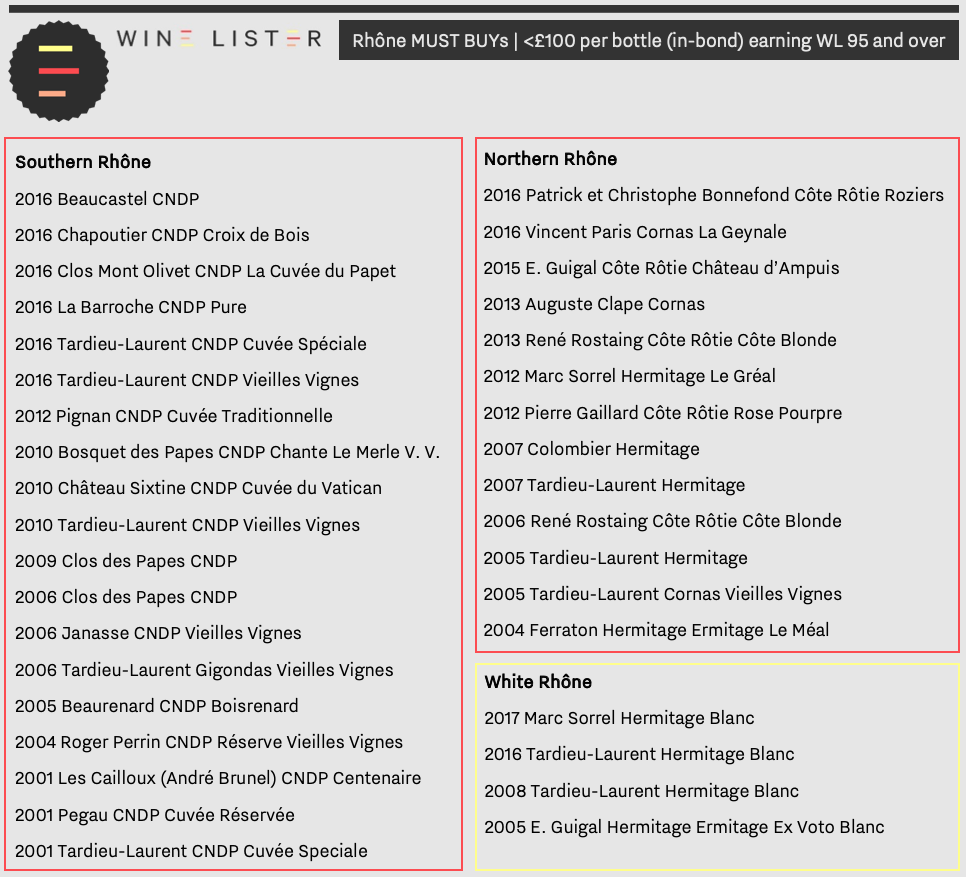
Châteauneuf-du-Pape wins the lion’s share of top Rhône MUST BUYs under £100, with 18 entries across eight different vintages. The exceptional 2016 vintage features heavily, however for wines drinking now, 2005 Beaurenard’s CNDP Boisrenard or 2009 Clos des Papes’ CNDP are particularly interesting options.
Hermitage too fairs well, with five reds and all four whites. Value Picks 2007 Colombier Hermitage and 2004 Ferraton Ermitage Le Méal provide impressive quality and bottle age for just £33 and £35 per bottle in-bond respectively (if you can get your hands on any).
Côte Rôtie matches in number for reds, and features Hidden Gem 2012 Côte Rôtie Rose Pourpre from Pierre Gaillard, which Wine Lister partner critic, Jancis Robinson, awards 18 points, commenting, “No doubt this is a very special cuvée”.
A consistent feature throughout is Maison Tardieu-Laurent – a powerhouse producer of reference for quality matched by exceptional value in the Rhône.
See the selection of Rhône MUST BUYs featured above here, or browse the full MUST BUY selection.
Earlier this week, we explored Wine Lister’s top red Value Picks (wines with the best quality-to-price ratios of all those in the Wine Lister database), noting that Tuscany and Bordeaux are the two best regions for value overall.
Having seen a noticeable lack of red Value Picks in Burgundy, the region’s white wines perform much better for quality-to-price ratio. The chart below shows the top eight regions for white Value Picks, and their average price per region.
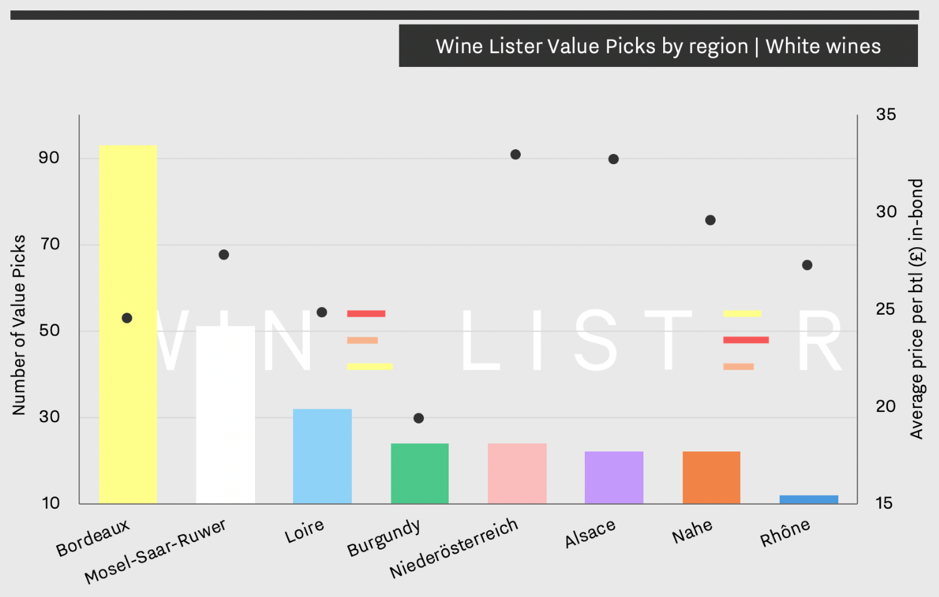
Of the 280 white Value Picks shown above, Bordeaux and the Mosel are heavily represented, in most part due to the impressive quality-to-price ratio of their sweet (or semi-dry) wines. Indeed, whites from Sauternes and Barsac make up all but one of the Bordeaux white Value Picks. While not the “most popular” these are some of the oldest Value Picks on Wine Lister, and include examples such as 1995 Clos Haut-Peyraguey, and 1996 Nairac.
The Loire provides a mix of different sweetness levels, however those achieving the highest quality are also sweet (such as 2006 Domaine Huet Clos du Bourg Moelleux).
Treading into Riesling-land, the Mosel and Nahe offer up the likes of Joh. Jos Prüm’s Wehlener Sonnenuhr Riesling Auslese Goldkapsel, and Dönnhoff’s Oberhäuser Brucke Riesling Auslese Goldkapsel. Alsace and Austria’s Niederösterreich produce some gems too (from the likes of Zind-Humbrecht and F.X. Pichler respectively), though of all white Value Picks these two regions are the most expensive on average.
Burgundy achieves 24 white Value Picks, the majority of which come from Chablis – the appellation which historically renders the best value for Burgundian whites. Other white Value Picks of note are Patrick Javillier’s Meursault Les Tillets, and Paul Pillot’s Chassagne-Montrachet Clos Saint-Jean.
See all white Value Picks here.
With Burgundy 2018 en primeur in full swing, soaring prices for some of Burgundy’s best can add to the January blues. While Burgundy prices tend to rise more quickly after release than any other region (making the en primeur buying system therefore extremely worthwhile), other regions provide better sources of good value wines for drinking, rather than cellaring for future consumption. To wave goodbye to any remaining blues as January come to a close, Wine Lister therefore looks this week at Value Picks from across fine wine regions.
Wine Lister’s Value Pick algorithm simply flags wines with the best quality-to-price ratios of all the wines in our database. A coefficient is applied to allow exceptional quality to be recognised, even for higher-priced wines.
The chart below shows the top nine regions for red Value Picks, and their average price per region.
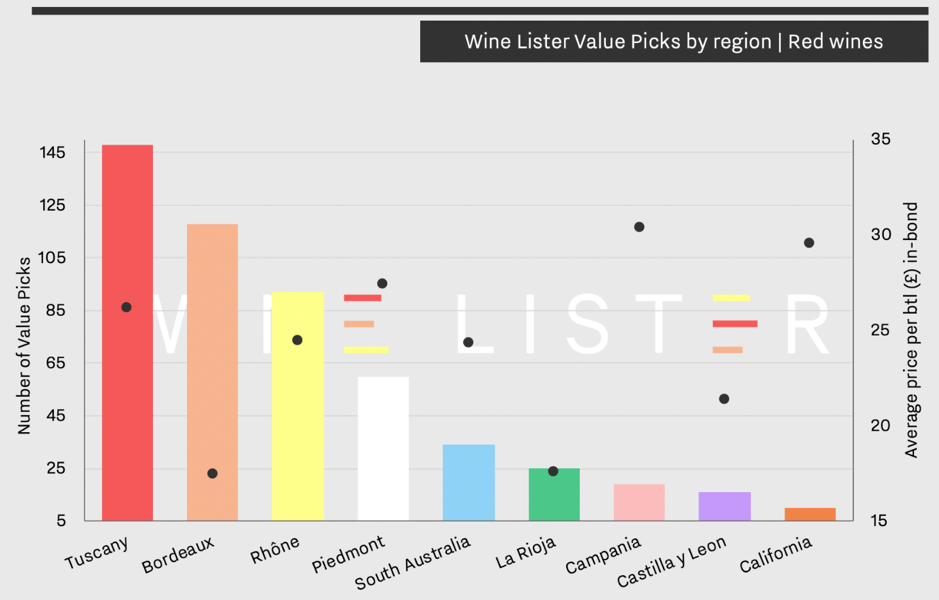
Italy takes the lead for number of best-value wines overall, with 227 Value Picks from across three regions – Tuscany, Piedmont, and Campania. Indeed, the top 10 Value Picks by WL score all hail from Tuscany, with wines such as Fontodi’s Chianti Classico Vigna del Sorbo Riserva, Isole e Olena’s Collezione Privata Syrah, and Castello dei Rampolla’s Sammarco making the cut.
Piedmont does not go wanting for Value Picks, with a wide range of suggestions, from Domenico Clerico’s Barolo Ciabot Mentin to Vietti’s Langhe Nebbiolo Perbacco.
France also does well for Value Picks, with 210 reds entries between Bordeaux and the Rhône. The former region has the lowest average price of all Value Pick regions shown above (£17.47 per bottle in-bond – when buying a full case), and includes Crus Classés from across appellations such as Malartic-Lagravière Rouge and Grand Mayne, as well as some second wines of Grands Crus châteaux (e.g. Pichon Comtesse’s Réserve de la Comtesse, and La Dame de Montrose).
The Rhône is home to 93 Value Picks from both north and south, and provides a list particularly strong in back vintages. Entries include Ferraton’s Hermitage Les Dionnières 2004, and Clusel Roch’s Côte Rôtie 2009.
The new world is well-represented by Value Picks from Australia across the McLaren Vale and Barossa Valley. California also makes an appearance, although perhaps expectedly, its 10 Value Picks earn the highest average price of any region shown in the chart above.
Search through all red Value Picks here.
Burgundy is, quite noticeably, missing from the top red Value Picks chart. It achieves just four in total: 2002 Joseph Drouhin Gevrey-Chambertin, 2003 Confuron-Cotetidot Echezeaux, 2017 Bertrand Ambroise Nuits-Saint-Georges, and 2007 Bouchard Volnay Clos des Chênes. However, Burgundy is much more present for whites – watch this space for white Value Picks later in the week.















